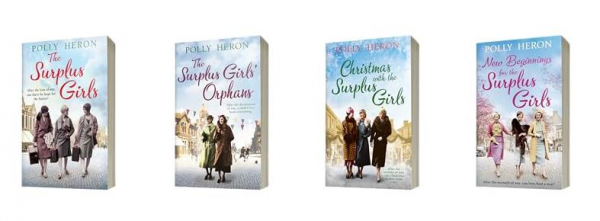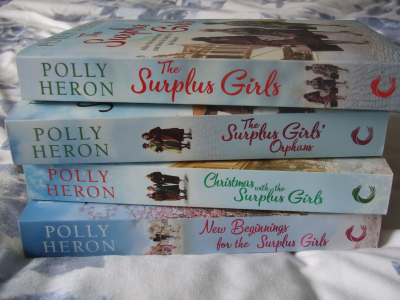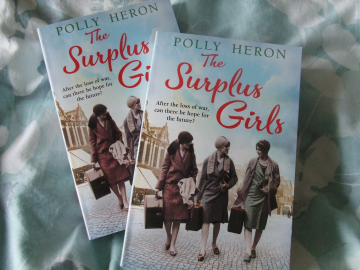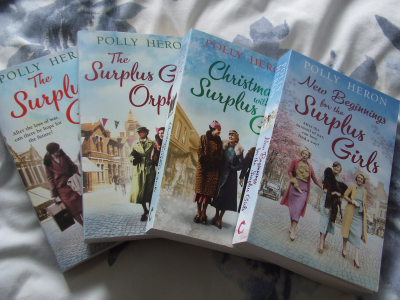
Who were the Surplus Girls?
The Great War wiped out a generation of young men and left behind a generation of young women who faced a life without the probability of marriage, at a time when any girl left on the shelf rapidly became an old maid and no working woman could hope to earn what could be earned by a man, even by a man doing the same job. These were the ‘surplus girls’ – young women who had grown up assuming they would get married, but whose dreams and assumptions were dashed by the War; young women who, unexpectedly and without preparation, faced a lifetime of work and spinsterhood.
* * * *
How the Hesketh Sisters Arrived in the 1920s... Via the 1800s, 1930s, 1910s and 1940s
Prudence and Patience Hesketh had been imaginary companions of mine for a long time. They first popped into my head in 1990 or ’91. In those days, they were the middle-aged spinster daughters of an impoverished country rector in Victorian times. I ended up not writing that particular book, but the Hesketh sisters hung around in my mind and a couple of years later I wrote the first version of what – 20 years later – became The Poor Relation.
c
In its first incarnation, The Poor Relation was set in the 1930s and Prudence and Patience were middle-aged spinster sisters with a very much younger half-sister, who was the heroine. Incidentally, if you have read The Poor Relation, the hero was Eleanor’s grown-up son. The trouble with that 1930s book was that I knew so much about the characters’ lives before the story started and it was all relevant to the plot… so I wrote another book, telling the tale of the previous generation – though I set it in Edwardian times rather than going back into the 19th century. At this point, the story began to look a bit more like the eventual The Poor Relation.
c
In this version, Prudence and Patience, for once, weren’t middle-aged but were youngsters. Although the book was fine in many ways, it wasn’t right, so I wrote another version, still in Edwardian times, but with Prudence now aged 23, but it wasn’t until 23-year-old Prudence Hesketh morphed into 23-year-old Mary Maitland that everything finally fell into place and The Poor Relation was written.
What next for the Hesketh sisters? Well, they went back to being middle-aged spinster sisters, only this time in the 1940s…. and there they stayed until The Surplus Girls came along and took them into the 1920s, and finally I had found the right book for them.

"The premise of this series brilliant."
I love this quote from Frost Magazine about the series. So let's talk about the premise.
The Surplus Girls series explores the predicament faced by many young women in the aftermath of the Great War. They had grown up expected by society to marry and become housewives and mothers. Then came the war – and a generation of young men perished. Many women lost their sweethearts or fiancés while others, without knowing it, lost the men they would have married had they ever had the chance to meet. This meant that many girls now faced a future in which they would have to provide for themselves, while being regarded as ‘on the shelf’ or ‘old maids’.
The world of work offered women far fewer opportunities than came the way of men. The wide variety of jobs that women had done very capably during the war when the men were away fighting seemed to be conventiently forgotten once the war ended. Moreover, a woman doing the same job as a man would typically earn one third less. This was considered normal – natural, even. The better salaries were given to the breadwinners, which meant the men, even at a time when there were many war widows supporting their families.
It was legal to refuse to employ a woman simply because she was a woman and it was considered patriotic to employ a former soldier even if a female candidate would have been more suited to the job. During an interview, an unmarried woman could expect to be grilled about her marriage prospects, because should she marry, the expectation would be that she would leave in order to be a housewife. In plenty of jobs, marriage automatically meant dismissal. In the nursing and teaching professions, which have always been female-dominated, it was required that women should leave work when they got married.
In The Surplus Girls series, I have explored various jobs that would have been open to girls and women in the early 1920s. Each book has a different heroine whom the story centres around, but one of the things that links the books together is that each heroine attends a business school to learn secretarial skills.
I loved delving into the social history of the time and seeking out suitable roles for my characters – ‘suitable’ meaning appropriate to the time, not necessarily the right job for the character personally – as Nancy finds out to her cost in Christmas with the Surplus Girls. In the fourth book, New Beginnings for the Surplus Girls, Jess makes a particularly interesting heroine, as she sees herself as a career woman, not an unfortunate surplus girl. She dreams of creating a successful working life for herself but has to cope with all the disadvantages that women faced at the time.

Never Say "Never!" With Research
Years ago, back in 1995, I read a book of oral history about living in the UK in the 1920s and '30s. A detail that sprang out at me immediately was recounted by a lady whose family started out in a house that was lit by oil-lamps. In those days, it was normal practice to prepare the bedtime oil-lamps in the kitchen, take them upstairs to bed and then bring them down again the next morning. The family then moved into a house that had - wonder of wonders! - electricity. At that point, they gave up their bedside oil-lamps for little electric lamps.... and brought them downstairs every morning, put them tidily away, and took them up to bed again the next night. Because that's what you do with your bedside lamps - right?
I loved that little detail because it said so much. I knew I was going to use it in one of my books.
This is why, whe we first meet Patience, at the beginning of Chapter 4 of The Surplus Girls, she is bringing her bedside lamp downstairs:
"Patience padded downstairs, carrying her bedside lamp, its flex neatly coiled. At the foot of the stairs, she passed the ornately carved monk's bench and opened the cupboard under the stairs to place the lamp on the shelf."
Later in the book, the Miss Heskeths are asked by a younger character why they do this.
I came across that detail way back in 1995 and it didn't get used until The Surplus Girls, which was written in 2019 and published in 2020.
All research gets used sooner or later - even if it has to wait for a quarter of a century!

Planning the Series and Meeting Belinda
Before I started writing my Surplus Girls Quartet, I planned it all out in meticulous detail. As well as writing a series, I wanted each of the books to be able to be enjoyed as a stand-alone.
To achieve this, I decided that:
- each book would have its own heroine and hero;
- the heroines would have secretarial school in common;
- the two sisters, Prudence and Patience Hesketh, who run the secretarial school would have a continuing story that progressed from book to book, but...
- each part of the Heskeths' story must feel complete to the reader of that individual book;
- characters from previous books would appear in the other books; and
- a tiny plot point in book 1 would become a major plot point in book 3.
I started by putting together a huge synopsis of 20-something pages, with each book's characters and plot written in detail. I didn't write it as a consecutive document - book 1, then book 2 etc. I wrote the synopses for all the books at the same time. This meant that if I got stuck, say, on Molly's story (book 2), I could switch to Nancy's (book 3) and concentrate on that for a while until I hit a wall, at which point I might switch back to Belinda in book 1.
When planning each book, I used the same formula:
- write about the heroine, her family background, her personality, her job, her hopes etc;
- ditto for the hero;
- work out the full plot, including information about the other characters;
- plan that book's allocation of the continuing story of the Hesketh sisters.
Here is what I wrote about Belinda, the heroine of book 1, in the synopsis:
In the first book, the heroine is BELINDA LAYTON. Belinda is from a large, impoverished family. The Laytons are pretty awful. They used to be respectable, hard-working working-class. But dad DENBY has gone from bad to worse where jobs are concerned and each job has dragged his family further down the social ladder. Mum KATHLEEN despairs of him and whenever she appears, you can smell the burning martyr. Denby is always trying to get money out of his three working children, much to Kathleen’s annoyance… but then she creeps after them and tries to wheedle money out of them herself.
Belinda moved in with her fiancé’s widowed mother ENID SLOAN and grandmother BEATTIE SLOAN when, aged 15, she got engaged; but her fiancé, BEN SLOAN, died towards the end of the Great War and since then Belinda has been a pretend-widow. She owes a lot to Enid and Beattie. Their cottage might be tiny but it is a big step up for Belinda, whose family is crammed into two rooms in a shabby house containing four families, all of whom share a stinking privy in the back yard. For Belinda, being invited to live with Enid and Beattie was a massive relief, but also a source of guilt, because she feels she shouldn’t be glad not to live with her family. Every week now, after she has tipped up for her bed and board with Enid and Beattie, and slipped Kathleen some money to help out, she has only a few coppers left for herself and she can’t see how to change this. Had Ben lived, it would have sorted itself out naturally once they got married, but now it feels like she is in a financial trap.
Belinda has received nothing but kindness from Enid and Beattie and is deeply grateful to them. Moreover, their shared grief has brought them extra close – but is she grateful enough to spend the rest of her life in mourning for Ben? For a long time she was happy to wear black and live in mourning, but now she wants to live a normal life again. She doesn’t expect ever to meet another man – she doesn’t even want to – but she is no longer content to live her life swathed in black. She wants to gain some skills so she can support herself and have a decent future, but Enid and Beattie struggle with the idea. Will Belinda rise above them in the world? They love her and don’t want to lose her, but above all, they believe Ben would want Belinda to stay with them.

Lawrence Hesketh - the making of a character
This - written from Patience's viewpoint - is how Lawrence is introduced into book 1, The Surplus Girls:
"For Prudence and Lawrence to be in the same room without arguing was unprecedented. Lawrence had always thrown his weight around, ever since they were children, and over the years he had become increasingly condescending towards them. Because they weren’t married? Probably. The world looked down on spinsters. But it wasn’t just that. Lawrence had risen in the world. He was a successful businessman and Evelyn revelled in her role as his perfectly-groomed wife."
But Lawrence didn't start out with that name. He started out as... Anthony. Then, towards the end of book 1, the orphanage that plays such an important role in the series is introduced in to the story - and, guess what, I called it St Anthony's. An instance of me not playing close attention to names? Maybe. It took a considerable time for me to realise what I'd done.
Well, the obvious thing would have been to rename the orphanage. After all, I had Anthony Hesketh very clearly in my head - I knew exactly what he looked like, how he behaved, the way he spoke, and all about him.
But - and it's a very big but - it was really important for the orphanage to be called St Anthony's - as you will already be aware if you're familiar with the series. So I ended up having to find a new name for Anthony Hesketh.
And the name that appeared in my head, demanding to be used, was Lawrence. Great. Except for one thing. Lawrence didn't look the same as Anthony - he's a lot taller, for one thing. And his personality was different too - cleverer, more sarcastic. So I had to go back and rewrite all the old Anthony scenes to make them suitable to be Lawrence scenes.
I ought to make it clear that this change of character didn't alter the plot in any way - it simply changed the manner in which the scenes and conversations that included Lawrence played out.
So there you are: changing a name isn't always as simple as pressing 'Find & Replace'. It all depends on what the character needs you to do.


